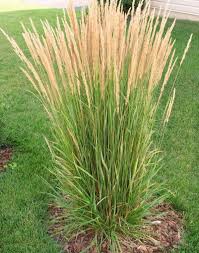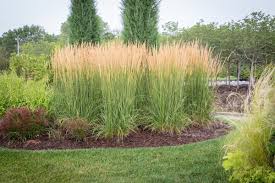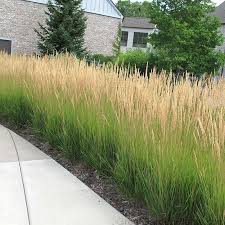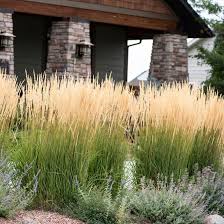Karl Foerster Grass, also known by its scientific name Calamagrostis x acutiflora ‘Karl Foerster,’ is a really nice plant that looks like tall, swaying grass. It grows upright and can reach about 4 to 5 feet tall. During early summer, it has fluffy parts that start purple and turn a golden tan color. When the wind blows, these fluffy parts make a soft sound.
The special thing about Karl Foerster Grass is that it can grow well in different sunlight levels, from sunny spots to places with a bit of shade. It doesn’t need a lot of care once it’s planted and settled. It doesn’t get thirsty often and can handle tough weather.
People who make gardens or design landscapes like using Karl Foerster Grass to make their places look nice. They plant a few of these grasses together or put one in a special spot. This grass can also stay in the ground during winter, so it adds beauty even when it’s cold outside.
If you want your garden to look pretty and you don’t want to spend too much time taking care of plants, Karl Foerster Grass is a good choice. It stands up tall and adds a nice touch to your yard, no matter if you’re really good at gardening or just starting to try it out. Whether you like modern styles or more classic ones, Karl Foerster Grass is a cool plant that will make your garden look great.
Read Also: Concrete Pond Management: Steps to take before introducing the Fish in the Water
Growing and Care Guide of Karl Foerster Grass

Below are the growing and caring guide for Karl Foerster Grass (Calamagrostis x acutiflora ‘Karl Foerster’):
1. Planting Location: Choose a spot in your garden that receives full sun to light shade. This grass can adapt to different light conditions, making it versatile for various areas.
2. Soil Preparation: Karl Foerster Grass is not too picky about soil, but well-draining soil is best. You can improve soil drainage by adding compost or other organic matter before planting.
3. Planting Time: The ideal time to plant is in early spring or fall. Dig a hole that’s about twice the size of the root ball, place the plant, and fill in with soil.
4. Watering: Water the grass regularly during its first growing season to help it establish its roots. After that, it’s quite drought-tolerant and won’t need as much watering.
5. Mulching: Apply a layer of mulch around the base of the grass to help retain moisture and suppress weed growth. Keep the mulch away from the stems to prevent rot.
6. Pruning: In late winter or early spring, cut back the dead or dormant growth from the previous year to make way for new growth. Trim the grass down to a few inches above the ground.
7. Fertilizing: Karl Foerster Grass doesn’t need a lot of fertilizer. You can apply a balanced, slow-release fertilizer in early spring if you want to give it a boost.
8. Winter Care: Leave the grass standing through the winter months. The dried plumes can add beauty to your garden and provide shelter for birds.
9. Dividing: Every few years, the grass might start to look crowded. You can divide it in early spring or fall by digging up the plant and splitting it into smaller sections. Replant the divisions and water well.
10. Pests and Diseases: Karl Foerster Grass is generally resistant to pests and diseases. Keep an eye out for any issues, but it’s likely to stay healthy with proper care.
Remember, while Karl Foerster Grass is quite low-maintenance, it’s always a good idea to keep an eye on it and make adjustments as needed. With a little care, this beautiful grass can thrive and add elegance to your garden or landscape.
Karl Foerster Feather Reed Grass

Karl Foerster Feather Reed Grass is a really cool plant that looks like tall, swaying grass with fluffy parts on top. Its full name is Calamagrostis x acutiflora ‘Karl Foerster.’ This grass grows nice and straight, reaching around 4 to 5 feet tall. In early summer, it gets these fluffy parts that start out purple and turn a golden tan color as they grow. When the wind blows, these fluffy parts make a gentle sound.
One great thing about Karl Foerster Feather Reed Grass is that it can handle different amounts of sunlight. It can grow well in spots that get a lot of sun or places with just a bit of shade. You don’t need to fuss over it too much once you plant it. It doesn’t need to drink water too often, and it’s tough enough to handle rough weather.
People who make gardens or design landscapes really like using Karl Foerster Feather Reed Grass to make their places look nice. They might plant a few of these grasses together or put one in a special spot. This grass can even stay in the ground during winter, so it keeps looking nice when it’s cold outside.
If you want your garden to look pretty and you don’t want to spend too much time taking care of plants, Karl Foerster Feather Reed Grass is a good choice. It stands up tall and adds a nice touch to your yard, whether you’re really good at gardening or just trying it out. Whether you like modern styles or more classic ones, Karl Foerster Feather Reed Grass is a cool plant that can make your garden look great.
Calamagrostis Karl Foerster

Calamagrostis Karl Foerster, also known as Karl Foerster Feather Reed Grass, is a splendid plant that resembles tall, swaying grass with fluffy parts on top. Its scientific name is Calamagrostis x acutiflora ‘Karl Foerster.’ This grass grows in a straight and elegant manner, reaching heights of about 4 to 5 feet. During early summer, it produces fluffy parts that start off purple and gradually change to a lovely golden tan color as they mature. When a gentle breeze blows, these fluffy parts create a soothing rustling sound.
One of the remarkable qualities of Calamagrostis Karl Foerster is its ability to thrive in various sunlight conditions. It can flourish in areas that receive plenty of sunlight as well as those with a touch of shade. Once planted, this grass doesn’t require excessive attention. It doesn’t demand frequent watering and is resilient enough to withstand tough weather conditions.
Gardeners and landscape designers often favor Calamagrostis Karl Foerster to enhance the visual appeal of their creations. They might choose to plant several of these grasses together or feature a single one in a special location. This grass retains its attractiveness even during the winter months when it remains in the ground, providing a year-round source of beauty.
Whether you’re an experienced gardener or just beginning to explore gardening, Calamagrostis Karl Foerster is an excellent option if you wish to add a touch of elegance to your garden. Its impressive height and graceful appearance complement various styles of gardens, from modern to more traditional designs. With minimal effort, this remarkable grass can elevate the aesthetics of your garden and leave a lasting impression.
Read Also: Earthen Pond Management: Steps to take before putting the Fish in the Water
Uses of Calamagrostis Karl Foerster

Calamagrostis Karl Foerster, commonly known as Karl Foerster Feather Reed Grass, has a range of uses that make it a versatile and attractive addition to gardens and landscapes:
1. Vertical Accent: Planted individually or in groups, Karl Foerster Grass creates a striking vertical accent in your garden. Its tall and slender form adds height and structure, making it an eye-catching focal point.
2. Border Planting: This grass works well as a border plant, defining edges of garden beds, pathways, or borders. Its upright growth habit neatly separates different areas and adds a touch of elegance.
3. Screening and Privacy: Due to its tall growth, Karl Foerster Grass can be used to create a natural screen or divider in your outdoor space, providing a sense of privacy and seclusion.
4. Container Gardening: Planting Karl Foerster Grass in containers or pots can add a unique and modern touch to your outdoor living areas, patios, or balconies.
5. Wildlife Habitat: The fluffy plumes of this grass can provide shelter for small birds and insects. It contributes to a balanced ecosystem by attracting beneficial insects and birds to your garden.
6. All-Season Interest: Even in winter, the dried plumes of Karl Foerster Grass remain upright and add texture and interest to the landscape. They can be especially captivating when covered in frost or snow.
7. Cut Flower Arrangements: The feathery plumes make excellent additions to cut flower arrangements. They bring a touch of the outdoors indoors and can be enjoyed as part of floral displays.
8. Erosion Control: The deep root system of this grass helps stabilize soil and prevent erosion, making it useful in areas prone to soil movement.
9. Low-Maintenance Landscaping: Karl Foerster Grass requires minimal care once established, making it a great choice for those who want a visually appealing landscape without extensive upkeep.
10. Drought-Tolerant Landscapes: Its ability to tolerate drought conditions makes it suitable for xeriscaping and water-wise gardens, helping conserve water resources.
11. Background Planting: This grass can serve as a backdrop for other flowering plants, creating a harmonious and balanced visual arrangement.
Whether you’re designing a modern landscape, a traditional garden, or a wildlife-friendly space, Calamagrostis Karl Foerster offers a wide range of uses that contribute to the beauty and functionality of your outdoor environment.
Read Also: Everything You Need to Know About LA’s Recycling Center
